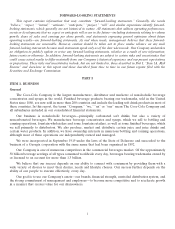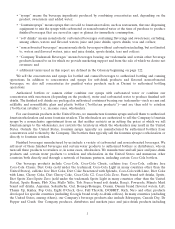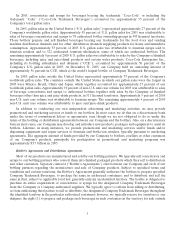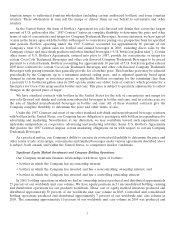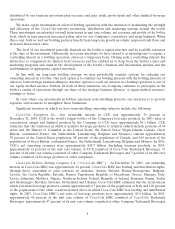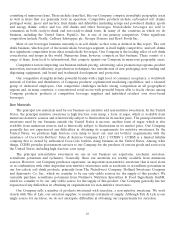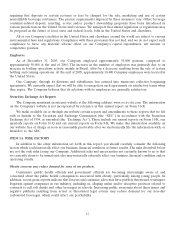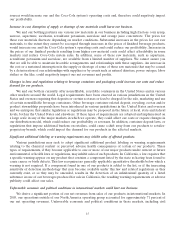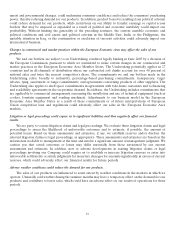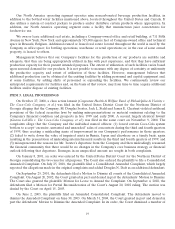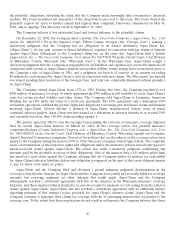Coca Cola 2005 Annual Report Download - page 12
Download and view the complete annual report
Please find page 12 of the 2005 Coca Cola annual report below. You can navigate through the pages in the report by either clicking on the pages listed below, or by using the keyword search tool below to find specific information within the annual report.consisting of numerous firms. These include firms that, like our Company, compete in multiple geographic areas
as well as firms that are primarily local in operation. Competitive products include carbonated soft drinks;
packaged water; juices and nectars; fruit drinks and dilutables (including syrups and powdered drinks); sports
and energy drinks; coffee and tea; still drinks and other beverages. Nonalcoholic beverages are sold to
consumers in both ready-to-drink and not-ready-to-drink form. In many of the countries in which we do
business, including the United States, PepsiCo, Inc. is one of our primary competitors. Other significant
competitors include Nestl´
e, Cadbury Schweppes plc, Groupe Danone and Kraft Foods Inc.
Most of our beverages business currently is in soft drinks, as that term is defined in this report. The soft
drink business, which is part of the nonalcoholic beverages segment, is itself highly competitive, and soft drinks
face significant competition from other nonalcoholic beverages. Our Company is the leading seller of soft drink
concentrates and syrups in the world. Numerous firms, however, compete in that business. These consist of a
range of firms, from local to international, that compete against our Company in numerous geographic areas.
Competitive factors impacting our business include pricing, advertising, sales promotion programs, product
innovation, increased efficiency in production techniques, the introduction of new packaging, new vending and
dispensing equipment, and brand and trademark development and protection.
Our competitive strengths include powerful brands with a high level of consumer acceptance; a worldwide
network of bottlers and distributors of Company products; sophisticated marketing capabilities; and a talented
group of dedicated employees. Our competitive challenges include strong competition in all geographical
regions and, in many countries, a concentrated retail sector with powerful buyers able to freely choose among
Company products, products of competitive beverage suppliers and individual retailers’ own store-brand
beverages.
Raw Materials
The principal raw materials used by our business are nutritive and non-nutritive sweeteners. In the United
States, the principal nutritive sweetener is high fructose corn syrup, a form of sugar, which is available from
numerous domestic sources and is historically subject to fluctuations in its market price. The principal nutritive
sweetener used by our business outside the United States is sucrose, another form of sugar, which is also
available from numerous sources and is historically subject to fluctuations in its market price. Our Company
generally has not experienced any difficulties in obtaining its requirements for nutritive sweeteners. In the
United States, we purchase high fructose corn syrup to meet our and our bottlers’ requirements with the
assistance of Coca-Cola Bottlers’ Sales & Services Company LLC (‘‘CCBSS’’). CCBSS is a limited liability
company that is owned by authorized Coca-Cola bottlers doing business in the United States. Among other
things, CCBSS provides procurement services to our Company for the purchase of various goods and services in
the United States, including high fructose corn syrup.
The principal non-nutritive sweeteners we use in our business are aspartame, saccharin, sucralose,
acesulfame potassium and cyclamate. Generally, these raw materials are readily available from numerous
sources. However, our Company purchases aspartame, an important non-nutritive sweetener that is used alone
or in combination with other important non-nutritive sweeteners such as saccharin or acesulfame potassium in
our low-calorie soft drink products, primarily from The NutraSweet Company, Holland Sweetener Company
and Ajinomoto Co., Inc., which we consider to be our only viable sources for the supply of this product. We
currently purchase acesulfame potassium from Nutrinova Nutrition Specialties & Food Ingredients GmbH,
which we consider to be our only viable source for the supply of this product. Our Company generally has not
experienced any difficulties in obtaining its requirements for non-nutritive sweeteners.
Our Company sells a number of products sweetened with sucralose, a non-nutritive sweetener. We work
closely with Tate & Lyle, our sucralose supplier, to maintain continuity of supply. Although Tate & Lyle is our
single source for sucralose, we do not anticipate difficulties in obtaining our requirements for sucralose.
10



